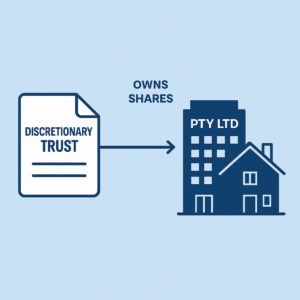Managing Land Tax Effectively: How Multiple Trusts Can Optimise Property Investments
John has successfully built a significant property portfolio in Queensland, holding his investments under a single trust. As his business continues to grow, he’s eyeing additional property acquisitions in Queensland. However, with property investments comes the challenge of managing land tax liabilities. In Queensland, land tax can be quite high when multiple properties are held under a single trust because only one land tax threshold applies to that trust. To optimise his land tax strategy and ensure continued growth of his property portfolio, John is considering setting up another trust. This blog will explore how using multiple trusts can help manage land tax more effectively, allowing property investors like John to maximise their returns.

The Problem: Rising Land Tax Liabilities with a Single Trust
John’s current property portfolio is held under one trust, which has served him well. However, as he plans to acquire more investment properties, he’s aware of the potential tax implications. In Queensland, each trust is entitled to a separate land tax threshold. If John continues to acquire properties under the same trust, the total land value will exceed the threshold, resulting in higher land tax liabilities. For property investors, land tax can represent a significant cost, eating into the returns from their investments. John wants to find a way to manage his land tax obligations more effectively to ensure his property investments remain financially viable.
The Solution: Establishing Multiple Trusts for Property Investment
To address the issue of rising land tax, John can consider setting up another trust to hold his new property acquisitions. This strategy allows him to take advantage of the land tax thresholds available to each trust, reducing his overall tax liability.
- Creating a New Trust for Additional Properties:
By establishing a second trust, John can purchase new investment properties under this separate entity. In Queensland, each trust is treated independently for land tax purposes, which means that each trust receives its own land tax threshold. This effectively doubles the amount of land that can be held before higher land tax rates apply. By spreading his properties across multiple trusts, John can keep the value of land under each trust below the threshold, minimising his land tax payments.
Benefits of Using Multiple Trusts:
-
- Tax Efficiency: By managing his property investments through multiple trusts, John can optimise his land tax liabilities, potentially saving a substantial amount in taxes each year.
- Risk Management: Separate trusts also provide a layer of asset protection. Should one trust face legal issues or claims, the properties in the other trust remain unaffected. This separation can safeguard John’s overall investment portfolio.
- Flexibility in Property Management: Using multiple trusts can offer greater flexibility in managing and distributing income from properties, catering to different investment strategies and beneficiary needs.
- Applicability in Other States:
This strategy is not limited to Queensland. In states like Victoria and New South Wales, similar tax benefits can be achieved because trusts are not grouped for land tax purposes. By setting up separate trusts in these states, property investors can manage land tax more effectively, optimising their investment returns.
Considerations and Best Practices
While the strategy of using multiple trusts offers significant advantages, it’s essential to approach this method with careful planning and professional advice:
- Legal and Tax Advice: Setting up multiple trusts involves legal and tax complexities. John should consult with legal and accounting professionals to ensure compliance with state regulations and to structure the trusts in a way that maximises tax efficiency without inadvertently creating other tax liabilities.
- Administrative Costs: Managing multiple trusts can increase administrative work and costs, such as setting up new trusts, ongoing compliance, and managing separate bank accounts and records. John should weigh these costs against the potential tax savings to determine if this strategy is financially viable.
- Long-Term Strategy: John should consider his long-term investment goals and how multiple trusts align with his overall financial strategy. This approach should not only provide immediate tax benefits but also support his future property acquisitions and investment plans.
Conclusion: Smart Property Investment with Multiple Trusts
For property investors like John, managing land tax efficiently is crucial to maximising investment returns. By establishing multiple trusts, John can optimise his land tax strategy, reduce his tax liabilities, and continue growing his property portfolio without unnecessary financial burdens. This approach offers not only tax benefits but also added layers of asset protection and flexibility in managing his investments.
If you’re a property investor looking to expand your portfolio and minimise land tax, consider exploring the use of multiple trusts. Engaging with experienced legal and tax advisors can help you navigate the complexities and ensure your investment strategy is both compliant and financially advantageous.
Others
-
October 20, 2025 Buying Property Under Your Personal Name in Australia: Pros and Cons
-
October 18, 2025 Service Trust Business Structure in Australia




